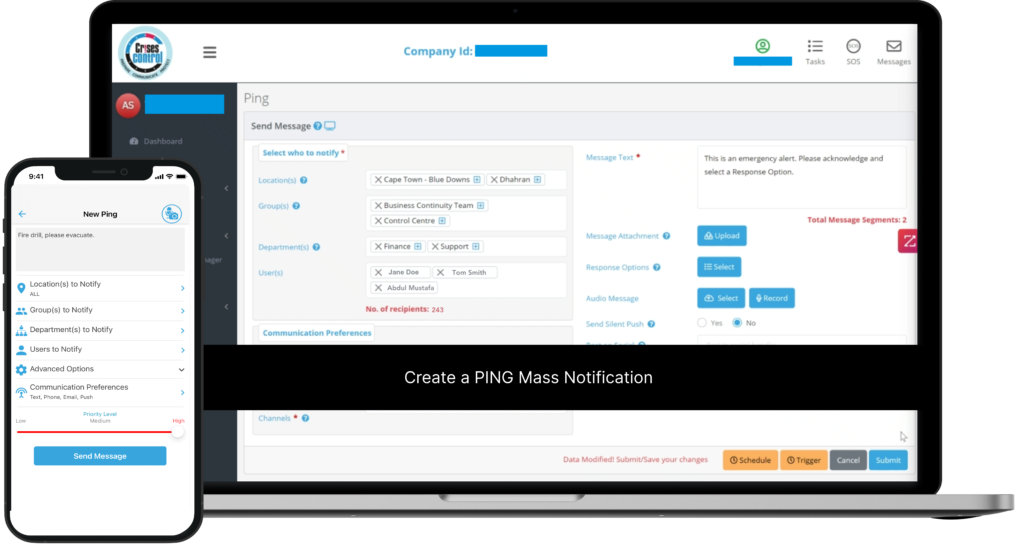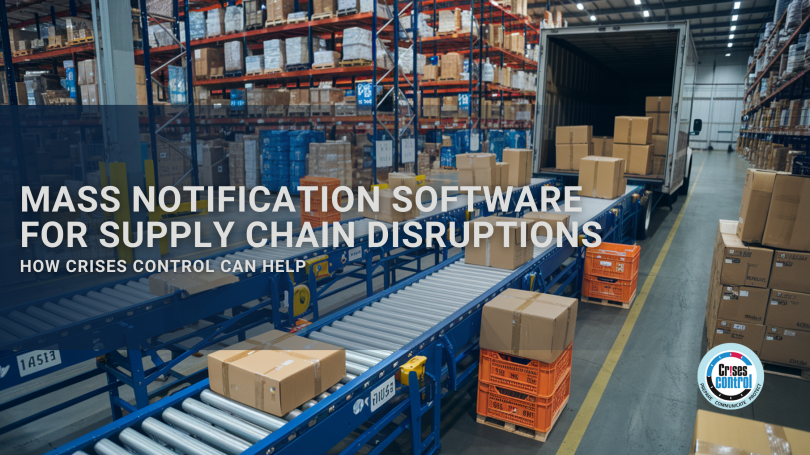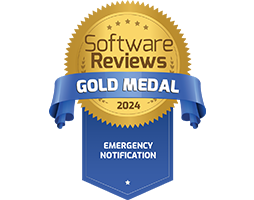Written by Anneri Fourie | Crises Control Executive
When something goes wrong in your supply chain, time starts working against you. Deliveries are delayed, products don’t arrive, and business operations slow down. But it’s not always the disruption itself that causes the most damage—it’s poor communication. If customers, suppliers, or internal teams don’t know what’s happening, they fill in the blanks themselves. That’s when frustration builds and reputations suffer.
This blog breaks down how mass notification software helps you take control of stakeholder communication when your supply chain is under pressure. We’ll look at how targeted messaging, automation, and incident management tools can reduce confusion, speed up responses, and keep your reputation intact.
Why Timely Communication Is Critical During Supply Chain Disruptions
Supply chains are fragile. They depend on multiple moving parts, often spread across different regions and time zones. A problem in one location can cause delays and uncertainty everywhere else. When disruptions hit, your first priority, alongside resolving the issue, is to manage expectations.
But many organisations still rely on outdated tools like email chains or ad hoc phone calls to share updates. That’s where problems start. Different teams hear different versions of events. Customers are left waiting without answers. Executives feel blindsided.
Mass notification software for supply chain disruptions solves this by giving you a fast, structured, and reliable way to get the right message to the right people—no guesswork, no crossed wires.
What Sets Mass Notification Software Apart?
Mass notification software isn’t just another messaging tool. It’s built specifically for emergency communication and crisis coordination. Here’s what makes it different:
Multi-Channel Delivery
You can send alerts via SMS, email, push notifications, voice calls, and even desktop pop-ups, all at the same time. This increases the chance your message is received, especially if certain systems are down.
Segmented Audiences
You don’t need to blast the same message to everyone. Segment stakeholders into groups, like suppliers, customers, or internal teams, and send tailored updates that are relevant to each audience.
Real-Time Tracking
You can see exactly who received the message and whether they’ve acknowledged it. This gives you insight into where follow-up might be needed.
Automation
You can trigger predefined messages from incident response plans, cutting down time and manual effort during a fast-moving situation.
Crafting a Supply Chain Crisis Communication Strategy with Mass Notification Software
Being quick to respond is only part of the solution. The content and structure of your message matter just as much. A strong communication strategy combines speed with clarity, relevance, and control. Here’s how to build one:
1. Prepare Before Disruption Hits
You can’t build a good communication plan in the middle of a crisis. It has to be done ahead of time. Start by:
- Defining your key stakeholder groups
- Creating message templates for common scenarios (e.g. factory shutdowns, customs delays, IT system failures)
- Choosing which channels to use for each group
- Making sure your notification system integrates with your incident management tools
Preparation turns chaos into a checklist.
2. Automate When You Can
Sending manual updates in a high-pressure situation increases the chance of mistakes. With incident management software, you can link incident types to specific notification workflows.
For example, if a supplier misses a delivery due to a strike, you can trigger a “Supplier Delay” scenario in your system. That action sends tailored alerts to procurement, warehouse, and customer service teams, without needing to type out anything new.
3. Be Clear and Direct
Messages during a disruption should be short, factual, and action-focused. Make sure your alerts answer these four questions:
- What happened?
- Who or what is affected?
- What is being done about it?
- What action (if any) do recipients need to take?
Vague language or over-explaining wastes time and adds to the confusion.
4. Keep Messaging Consistent
If different departments or customer groups receive different updates, it creates mistrust and inefficiency. With mass notification software, you can send one consistent message across all teams and still tailor it slightly for different audiences.
This ensures the sales team doesn’t promise something the operations team can’t deliver, and customers aren’t hearing rumours instead of facts.
5. Enable Two-Way Communication
In some situations, you need to hear from stakeholders, not just talk to them. For example, a logistics team might report road closures, or a supplier might confirm alternate delivery timelines. Two-way mass notifications allow you to collect this feedback in real time, improving your situational awareness and decision-making.
How Crises Control Helps You Stay Ahead of Disruption
At Crises Control, we specialise in helping organisations stay connected and in control during uncertain times. Our platform combines mass notification software and incident management software to give you a complete communication toolkit. Here’s how we support your response strategy:
Ping Mass Notification
With one click, send high-priority alerts across multiple channels to segmented groups. You can notify thousands of stakeholders instantly, and track responses live.
Stakeholder Grouping and Personalisation
Easily create and manage stakeholder groups. Send precise messages to different teams, suppliers, or customer groups, keeping each one informed without overloading them with irrelevant information.
Pre-Built Incident Templates
Choose from a library of ready-to-use templates for common supply chain scenarios. You can also create your own based on your unique risks. This standardises responses and saves time when it matters most.
Real-Time Acknowledgement Tracking
See who has received, opened, and acknowledged each message. If a critical stakeholder hasn’t responded, you’ll know right away and can follow up quickly.
Resilient Mobile App
Our platform continues to operate via our mobile app, even if your main systems like email or Microsoft services go down. That means communication doesn’t stop just because one platform does.
Flexible Hosting Options
Crises Control runs on a robust, independent cloud infrastructure with 99.999% uptime. We also offer local hosting to meet data sovereignty requirements, particularly useful for organisations working in regulated environments.
Interested in our Ping Mass Notification Software?
Efficiently alert everyone in seconds at scale with our Mass Notification Software – PING, get the message out fast and ensure rapid response and recovery.

Conclusion: Fast Communication Builds Confidence
When supply chain disruptions happen, you’re racing against time. Every minute counts. But communication is where you can gain ground, not lose it. A delayed shipment doesn’t have to become a reputational disaster if your stakeholders are kept informed and engaged.
Crises Control gives you the tools to communicate clearly, quickly, and with confidence. With our mass notification software and incident management software working together, you can deliver the right message, to the right people, in the right way—no matter how complex the situation.
Get a free personalised demo of Crises Control today and see how our platform can help you take charge of your crisis communication.
Request a FREE Demo









